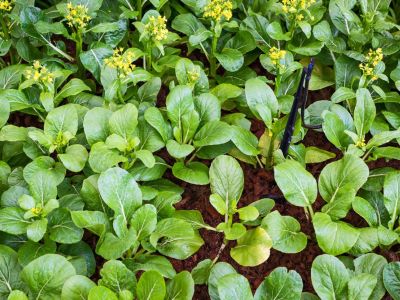Bok Choy Plant Bolt
Bok choy (Brassica rapa) is an Asian vegetable that also goes by the names of Chinese white cabbage or Chinese mustard. It’s a member of the mustard family, and therefore, a cool season vegetable that should be grown in the spring or fall. It is a non-heading cabbage with dark green leaves and white leaf stalks and is grown as an annual. Horticulturally, in leafy greens such as bok choy, bolting is the premature growth of a long stalk carrying a flower head, so early flowering bok choy is a sure sign that your bok choy is bolting.
How to Prevent Bolting in Bok Choy
There are several answers to what it means when bok choy bolts and how to prevent bolting. In bok choy, the key factor is shock, which can be caused by transplanting, temperature, and water. It’s a sign your plant is ‘panicking’ and feels the need to propagate (make seed) as quickly as possible. First, choose a variety that is slow to bolt, particularly if you live in an area where radical temperatures are common. Choose your site carefully. Bok choy needs sun, but as the weather warms, all day sun will cause your garden soil temperature to rise. You’ll be planting in the spring before trees are fully leafed out. Choose a spot that will eventually have some shade. Six to eight hours of direct sun is all that’s needed. If sunny spots are all that’s available, you might consider creating shade with a tarp. Transplanting can cause shock. For spring planting, sow your seed directly into nitrogen rich soil as soon as all danger of frost has passed. The ideal temperature for bok choy is between 55 and 70 degrees F. (13-21 C.). Be aware that bok choy plant bolt can occur when nighttime temperatures drop below 55 degrees F. (13 C.). Of course, Mother Nature can never be completely relied on, so one of the easiest answers for how to prevent bolting in bok choy is to grow it in a cold frame where you have more control over temperature. Too much or too little water can also cause bok choy bolting. Your soil should drain well and your plants should receive about one inch (2.5 cm.) of water per week and the soil remains damp between watering. Successive plantings are seldom effective as a way to prevent bolting bok choy. Young bok choy plants bolt as quickly as mature ones. Lastly, begin harvesting early. You don’t have to wait for the entire plant to mature to harvest the larger outer leaves, and as soon as you see signs of your bok choy bolting, harvest the entire plant and use the smaller leaves in salads. According to several excellent cooks I know, flowering bok choy isn’t the disaster some gardeners think. They claim that the flower stalks are tender and sweet and make a great addition to stir-fry and salads. Bok choy is one of the more finicky choices to plant in your garden, but the rewards of a successful season can make it all worthwhile. Those of us who love this difficult-to-grow Asian vegetable know what it means when bok choy bolts. All it means to us is there’s always another gardening season on the horizon and next year, we’ll get it right.
